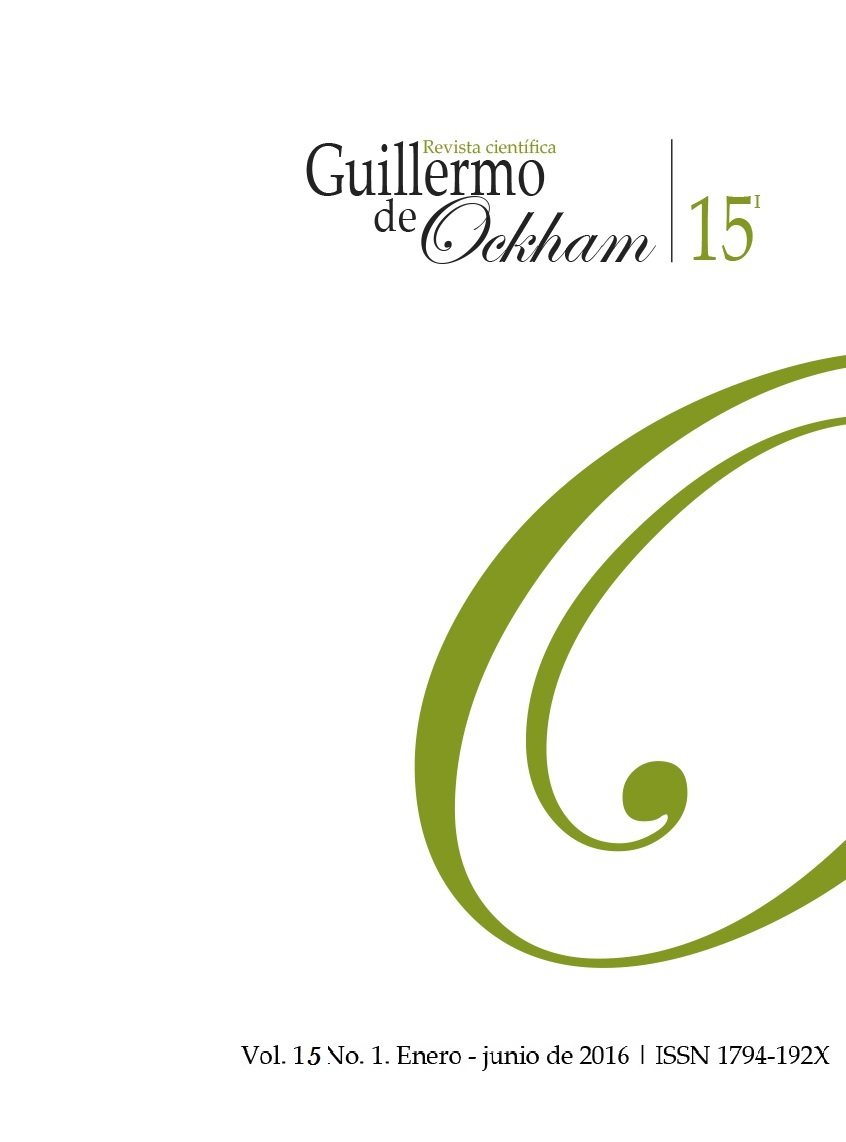La Revista Guillermo de Ockham brinda un acceso inmediato y abierto a su contenido, basado en el principio de ofrecer al público un acceso gratuito a las investigaciones para brindar un intercambio global de conocimiento. A menos que se establezca lo contrario, el contenido de esta revista tiene una licencia con Creative Commons Attribution-NonCommercial-NoDerivatives 4.0 International (CC BY-NC-ND 4.0) http://creativecommons.org/licenses/by-nc-nd/4.0/
- Atribución: debe otorgar el crédito correspondiente, proporcionar un enlace a la licencia e indicar si se realizaron cambios. Puede hacerlo de cualquier manera razonable, pero no de ninguna manera que sugiera que el licenciante lo respalda a usted o su uso.
- No comercial: no puede utilizar el material con fines comerciales.
- Sin derivados: si remezcla, transforma o construye sobre el material, no puede distribuir el material modificado.
- Sin restricciones adicionales: no puede aplicar términos legales o medidas tecnológicas que restrinjan legalmente a otros de hacer cualquier cosa que permita la licencia.
Resumen
This study aims to analyze the evolution of the weekly working hours (WWH) of the Brazilian population in relation to its free time and the Human Development Indicator (HDI) from 2008 to 2012. In this study, data were collected from the National Sample Household Survey (NSHS) and from the United Nations Development Programme for Development (PNUD). The data were systematically compared by determining the temporal correlations between the HDI, WWH, housework and Brazilian workers’ free time. A gender subgroup was analysed in order to observe different inferences for each of these categories and its relationship with work. The results show that the HDI is directly proportional to the WWH for women and inversely proportional to the WWH for men. It was also found that the number of weekly working hours was higher for women than it was for men. Over the years, women have made a greater contribution to the development of the HDI than men, mainly due to increases in their presence in the labour market, combined with the reduction in gender inequality in society.
Palabras clave:
Referencias
Bernardo, J. (2001). Transnacionalização do capital e fragmentação dos trabalhadores. São Paulo, Boitempo.
Buss, P. M. (2000). Promoção da saúde e qualidade de vida. Ciência & Saúde Coletiva, 5(1), 163–177.
Codo, W., Soratto, L., & Vasques-Menezes, I. (2004). Saúde mental e trabalho. In J. C. Zanelli, J. E. Borges- Andrade, & A. V. B. Bastos (Eds.), Psicologia, organizações e trabalho no Brasil (pp. 276-299). São Paulo: Artmed.
Elisa, N., & Dunning, E. A. (1992). Busca da excitação. Lisboa, Difel.
Field, A. (2009). Descobrindo a estatística usando o SPSS. (2nd ed.). Porto Alegre: Artmed.
Fürstenberg, F. (1994). Arbeit & Freizeit-Zugeschriebene Bedeutungen. Lebensqualität. VS Verlag für Sozialwissenschaften, 85–99.
Hammell, K. W. (2004). Dimensions of meaning in the occupations of daily life. Canadian Journal of Occupational Therapy, 71.5: 296–305.
Haworth, J., & Lewis, S. (2005). Work, leisure and well-being. British Journal of Guidance & Counseling, 33(1), 67-79.
Hirata, H. S. (2004). O universo do trabalho e da cidadania das mulheres: um olhar do feminismo e do sindicalismo. Reconfiguração das relações de gênero no trabalho. São Paulo: CUT, 13-20.
Howell, D. (2012). Interpreting and evaluating the CASP-19 quality of life measure in older people. Age and Ageing, 41: 612–617.
Instituto Brasileiro de Geografia e Estatística (IBGE). (2014). < http://www.ibge.gov.br/home/estatistica/populacao/condicaodevida/indicadoresminimos/suppme/analiseresultados2.shtm> Accessed on December 27th 2014.
Instituto Brasileiro de Geografia e Estatística (IBGE). (2016). < http://brasilemsintese.ibge.gov.br/educacao/anos-de-estudo-e-sexo.html> Accessed on Feb. 20th 2016.
Jannuzzi, P. M. (2014). Indicadores para diagnóstico, monitoramento e avaliação de programas sociais no Brasil. Revista do Serviço Público, 56(2): 137–160.
Kay T. (2000). Leisure, gender and family: The influence of social policy. Leisure Studies, 19(4), 247-265.
Lima, M. E. (2002). Esboço de uma crítica à especulação no campo da saúde mental e trabalho. In M. G. Jacques & W. Codo (Eds.), Saúde mental & trabalho: Leituras (pp. 50-81). Petrópolis, RJ: Vozes.
Marz, K. (1983). O capital. São Paulo: Abril.
Minayo, M. C. S., Hartz, Z. M. A., & Buss, P. M. (2000). Qualidade de vida e saúde: Um debate necessário. Ciência Saúde Coletiva, 5(1): 7–18.
Mohit, M. A. (2014). Present trends and future directions of quality-of-life. Procedia-Social and Behavioral Sciences, 153, 655–665.
Noronha, E. G. (2005). Informal, illegal and unfair: perceptions of labor markets in Brazil. Revista Brasileira de Ciências Sociais, 1(SE), 0-0.
Pesquisa Nacional por Amostra de Domicílios Contínua (PNAD) 2012 e 2013.
Pesquisa Nacional de Saúde (PNS).
Programa das Nações Unidas para o Desenvolvimento. Desenvolvimento humano e IDH (PNUD).
Ramos, M. D. O., Ulbanere, R. C., & Jesus, B. S. D. (2014). Mulheres no Mercado de Trabalho. Revista Científica Integrada, (4).
Schultz, I. L., Souza, R. A., Aratani, N., de Oliveira Mena, L. T., Contrera, L., & França, A. N. (2014, November). Acidentes com Materiais Perfurocortantes: Um Risco para os Profissionais de Enfermagem. In Encontro Regional Centro-Oeste 2014.
Wiggins, R., Higgs, P., Hyde, M., & Blane, D. (2004). Quality of life in the third age: Key predictors of the CASP-19 measure. Ageing and Society, 24: 693–708.
World Health Organization Quality of Life (WHOQOL) Group. (1996). World Health Organization Quality of Life Assessment, World Health Forum, 17: 354–356.
World Health Organization Quality of Life (WHOQOL) Group. (1998). Versão em português dos instrumentos de avaliação de qualidade de vida. Famed – Universidade Federal Do Rio Grande Do Sul – HCPA.
































